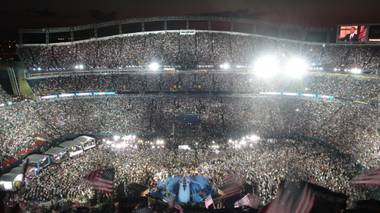Apparently if you run into Aspen residents outside of Aspen, they’re not likely to tell you where they live. “The Roaring Fork Valley” might be the best you get out of them—this modesty is, one imagines, the equivalent of Harvard alums vaguely telling people they went to school in Boston. Some places just carry too much expectation.
Founded in the 19th century as a mining town, Aspen’s history as a ski resort began in the mid Forties. In the Fifties and Sixties the old money came in; in the late Sixties and early Seventies it was the hippies. Hunter S. Thompson ran for sheriff of Pitkin County in 1970. He lost but inspired those hippies to take control of the town and the county. The quantity and quality of development has been tightly controlled since.
In Aspen you won’t see billboards or neon signs; the result is a town that feels more like a town than a resort, and that remains nearly as attractive as it’s breathtaking setting. (The telltale sign may not be the gorgeous Victorians or the attractive downtown, but the handsome street signs.)
But what you will find is wealth. Lots of wealth. So there is an Aspen the air of total fantasy, and watching young people strolling past a large soccer field, the game you find yourself intuitively playing is “Who belongs and who doesn’t.”
As Aspen has morphed from mining town to ski town to hippie haven to enclave of the rich and famous, its offbeat charms have been mostly steam cleaned, replaced by a high-gloss of Jet Set paint.
Aspen Daily News reporter Brent Gardner Smith calls this a funk scrape. Used to be you could rent one of those old Victorians on the west end of town and share it with six roommates, he says. Those same properties go for millions. (If you have only a million to spend here, don’t even bother.)
It’s so expensive to build here that those who do tend to maximize their investment in every make by making their homes as large and lavish as possible. Every megahouse in the mountains overlooking the town generates one to two workers in the economy—housing those employees is an extremely expensive proposition for Pitkin County officials (around $600 a square foot), so the county charges an impact fee to home owners. That fee used to be $34,000 per new worker; now it’s $225,000.
As towns throughout the Western Slope are becoming a little more liberal, Aspen is becoming a little more more conservative, as more wealthy Republicans have come and set up shop. By and large, those, these second- and third- and fourth-homeowners tend to vote someplace else.
There’s a growing working-class Latino population in Pitkin—about thirty minutes down the road in (still funky) Glenwood Springs, plenty of Latina moms navigate their kids through the old Wal-Mart store … Many Latinos here are illegal, but, says Gardner-Smith, “We can’t run this resort without them.” There are some affordable housing units in Aspen, though caps on appreciation means the workers who buy them are probably the only people who will never get rich owning real estate in Aspen.
Most of the non-wealthy who work in Aspen live down the Roaring Fork valley in places like Basalt, or Carbondale, or Glenwood Springs. In ten years, the workers may be pushed out of the Valley altogether, and west down I-70 to towns like Rifle, or even as far as Grand Junction, a distance of more than 120 miles.
The soured economy is no doubt hitting Aspen’s working class, but the main industry in this town is real estate, not tourism. “If you’re gonna go through a recession it’s nice to be at the top of the food chain. But even Aspen has felt it,” Gardner-Smith says. In other words, it’s getting harder to get that $10 million loan for that vacation home.
Real estate values may be on pause in Aspen, but don’t look for them to decline. They’re rather a ski lift that way. The chairs may stop for a moment from time to time, but you always know you’re going up.







Previous Discussion: